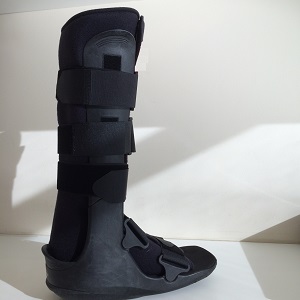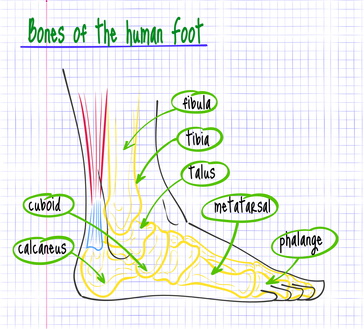Foot Fractures – Management and Rehabilitation
Foot fractures, that is, breaks in the bones in the feet, are an unwelcome reminder to be more careful with our feet. The pain of a broken bone in a foot thwarts natural weight bearing movement and we feel temporarily disabled . The pain can be excruciating.. To make matters worse, we have 26 bones, 33 joints and over 100 muscles, ligaments and tendons. Thus, the chances of a cracked or broken foot bone are high at some time in our lives. Stress fractures, particularly, are quite common in feet. Correct management is vital for all Foot Fractures.
Overview of foot function
Our feet bend and flex as we move. They are a powerful structures in which every element, from heel to toes, plays an important role. The bones, joints, ligaments, muscles and tendons all adjust for pressure as we walk, run, skip, and jump. Everything is in perfect harmony until we over stress the engineering.
Repetitive excessive strain can lead to stress foot fractures (as well as other musculo skeletal conditions). Single impact or strain can also result in fracture of bone. Unlike conventional broken bones that sudden traumas cause, often with immediate high levels of pain, stress fractures are the result of fatigue over relatively long periods. Examples are standing too long at a shop counter and pounding a treadmill at the gym.
The warning sign of a stress fracture is often the gradual onset of pain at a metatarsal or other part of the foot. If we ignore the bone’s warning message, it can develop a hairline fracture crack. At this stage, the crack can heal naturally with rest. However if we ignore the problem the edges can jar against each other, and develop into something more serious.
Management and Rehabilitation of Foot Fractures
The muscles and bones in our legs and feet are powerful structures capable of supporting our weight even as we climb mountains, or land from the sky by parachute. We call their semi-autonomous action ‘balance’. There are many components involved in balance and function, even when we are standing still. It is difficult to isolate particular vulnerable bones and soft tissues during day to day activities let alone through sports and active pursuits. Once we have identified a warning sign of a potential stress fracture or suspect we have a conventional fracture our entire focus must move firstly to reduce the risks of full fracture, in the case of warning pain, non-union healing and possible bone infection.
Confirmation of a Foot Fracture will require an X-ray or in some circumstances a bone scan or a CT scan. You will need to work through your Podiatrist or Doctor for this.

Immobilization is the gold standard for treatment of foot fractures. Immobilization stops the push and pull of muscles, ligaments and tendons on the affected bone. Management, recovery and rehabilitation is thus the only way a cracked or broken foot bone can heal. The healing process can take between two and four weeks for a simple hairline break. However it can take many months for the bone to ‘bulk up’ even though the pain is long gone. Immobilisation may take the form of Camboot or Plaster Cast, complete bed rest or wheelchair if complete non-weightbearing is required.
Rehabilitation is the stage which is almost as infuriating as the immobilisation stage. You will want to get going again. Your foot and your foot fracture might have different ideas.Standing and walking is a good place to start. Unfortunately some of your muscles will have lost condition, so you will need to work on these (your Podiatrist or Physical Therapist can help with this) and your fracture site may complain at the re-start of pushing and pulling of ligaments and tendons. Whether you a sportsperson, dancer, or average Joe you may need to allow a whole year before you are back to full function and power. Your rehabilitation, if accelerated by impatience, may result in a lifetime vulnerability of your foot health. If you are involved in an active ‘foot sport’, we recommend you skip a season and then only increase your training by 10% a week. The next time the bone breaks you may regret it for the rest of your life.
Other Considerations:
- Bone Disease: If you suffer from a debilitating bone disease like osteoporosis, you are more likely to crack or break a bone. Try your best to come to terms with this. Ask your physiotherapist what they recommend.
- Vitamin D Deficiency: We get Vitamin D, which is essential for healthy bones from sunlight. If you live in a climate where clouds are common in winter there is some evidence of the benefit of a moderate daily dose of a Vitamin D supplement. Check with your doctor.
- Bad Footwear: We get our foot DNA from ancestors who walked bare foot. Hence a shoe is an alien object at best. If your feet trouble you, speak to a chiropodist about the best footwear for your lifestyle.
- Poor Overall Condition: If you are office-bound, you are probably unfit and that goes for your feet. Decline all invitations to team hikes and seven-a-side rugby. Get fit first by walking regularly. Then you can try.
- Emerging concern….. There is some emerging concern that bone density is adversely affected by the consumption of large volumes of carbonated cola drinks. This is a still a contentious issue. Podiatrists and doctors are awaiting further studies.
Broken and cracked foot bones are debilitating injuries that can interfere with our lifestyle for months. Worst of all they are regularly underestimated as a long term, recurrent source of pain and disability. When foot pain happens, please consider the possibility of a foot fracture. Seek professional advice, confirm with X-ray, listen to your podiatrist or doctor. Management and rehabilitation are your best option with foot fractures.


Recent Comments